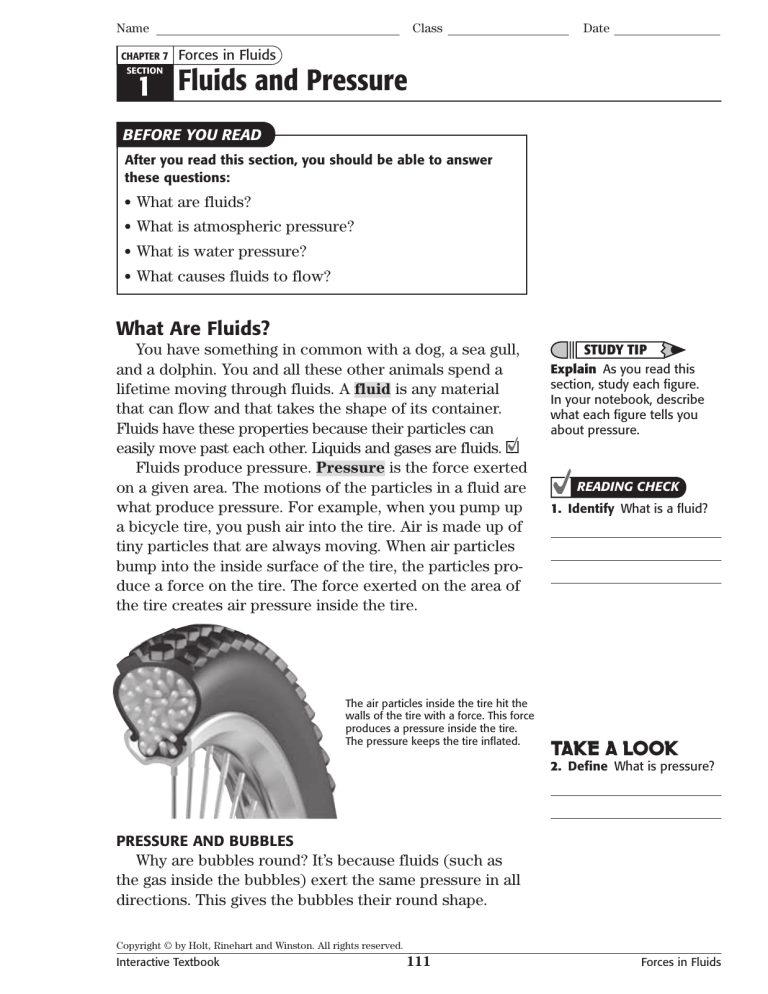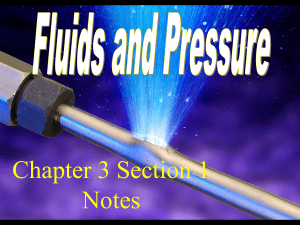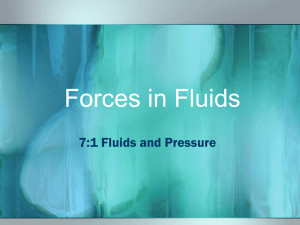
Name CHAPTER 7 Class Date Forces in Fluids SECTION 1 Fluids and Pressure BEFORE YOU READ After you read this section, you should be able to answer these questions: • • • • What are fluids? What is atmospheric pressure? What is water pressure? What causes fluids to flow? What Are Fluids? You have something in common with a dog, a sea gull, and a dolphin. You and all these other animals spend a lifetime moving through fluids. A fluid is any material that can flow and that takes the shape of its container. Fluids have these properties because their particles can easily move past each other. Liquids and gases are fluids. Fluids produce pressure. Pressure is the force exerted on a given area. The motions of the particles in a fluid are what produce pressure. For example, when you pump up a bicycle tire, you push air into the tire. Air is made up of tiny particles that are always moving. When air particles bump into the inside surface of the tire, the particles produce a force on the tire. The force exerted on the area of the tire creates air pressure inside the tire. The air particles inside the tire hit the walls of the tire with a force. This force produces a pressure inside the tire. The pressure keeps the tire inflated. STUDY TIP Explain As you read this section, study each figure. In your notebook, describe what each figure tells you about pressure. READING CHECK 1. Identify What is a fluid? TAKE A LOOK 2. Define What is pressure? PRESSURE AND BUBBLES Why are bubbles round? It’s because fluids (such as the gas inside the bubbles) exert the same pressure in all directions. This gives the bubbles their round shape. Copyright © by Holt, Rinehart and Winston. All rights reserved. Interactive Textbook 111 Forces in Fluids Name SECTION 1 Class Date Fluids and Pressure continued CALCULATING PRESSURE Remember that pressure is a force exerted on an area. You can use this equation to calculate pressure: force pressure _____ area Math Focus 3. Calculate What pressure is exerted by a crate with a weight of 3,000 N on an area of 2 m2? Show your work. The SI unit of force is the pascal. One pascal (Pa) is equal to a force of one newton pushing on an area of one square meter (1 N/m2). 1 Pa of pressure is very small. A stack of 120 sheets of notebook paper exerts a pressure of about 1 Pa on a table top. Therefore, scientists usually give pressure in kilopascals (kPa). 1 kPa equals 1,000 Pa. Let’s calculate a pressure. What is the pressure produced by a book that has an area of 0.2 m2 and a weight of 10 N? Solve pressure problems using the following procedure: force Step 1: Write the equation. pressure _____ area 10 N 50 ___ N 50 Pa Step 2: Substitute and solve. _____ 0.2 m2 m2 What Is Atmospheric Pressure? TAKE A LOOK 4. Describe What would be the length of the arrows if the balloon were inflated more? Explain your answer. The atmosphere is the layer of gases that surrounds Earth. Gravity holds the atmosphere in place. The pull of gravity gives air weight. The pressure caused by the weight of the atmosphere is called atmospheric pressure. Atmospheric pressure is exerted on everything on Earth, including you. At sea level, the pressure is about 101,300 Pa (101.3 kPa). This means that every square centimeter of your body has about 10 N (2 lbs) of force pushing on it. Why doesn’t your body collapse under this pressure? Like the air in a balloon, the fluids inside your body exert pressure. This pressure inside your body acts against the atmospheric pressure. Air pressure inside balloon Atmospheric pressure The air inside the balloon produces a pressure inside the balloon. The pressure inside the balloon equals the atmospheric pressure outside the balloon. Therefore, the balloon stays inflated. Copyright © by Holt, Rinehart and Winston. All rights reserved. Interactive Textbook 112 Forces in Fluids Name Class SECTION 1 Date Fluids and Pressure continued PRESSURE, ALTITUDE, AND DEPTH Increasing altitude It is very difficult to climb Mount Everest. One reason is that there is not very much air at the top of Mount Everest. The atmospheric pressure on top of Mount Everest is only about one-third of that at sea level. As you climb higher, the pressure gets lower and lower. At the top of the atmosphere, the pressure is almost 0 Pa. 12,000 m above sea level Airplanes fly at about 12,000 m above sea level. Atmospheric pressure there is about 20 kPa. 9,000 m above sea level The top of Mount Everest is about 9,000 m above sea level. Atmospheric pressure there is about 30 kPa. 4,000 m above sea level La Paz, the capital of Bolivia, is about 4,000 m above sea level. Atmospheric pressure in La Paz is about 51 kPa. 0 m above sea level At sea level, atmospheric pressure is about 101 kPa. Air pressure is greatest at Earth’s surface because the entire weight of the atmosphere is pushing down there. This is true for all fluids. As you get deeper in a fluid, the pressure gets higher. You can think of being at sea level as being “deep” in the atmosphere. PRESSURE CHANGES AND YOUR BODY What happens to your body when atmospheric pressure changes? You may have felt your ears “popping” when you were in an airplane or in a car climbing a mountain. Air chambers behind your ears help to keep the pressure in your ears equal to air pressure. The “pop” happens because the pressure inside your ears changes as air pressure changes. READING CHECK 5. Describe As altitude increases, what happens to atmospheric pressure? Math Focus 6. Calculate About what fraction of atmospheric pressure at sea level is atmospheric pressure at La Paz? READING CHECK 7. Explain Why is atmospheric pressure greatest at the surface of Earth? Copyright © by Holt, Rinehart and Winston. All rights reserved. Interactive Textbook 113 Forces in Fluids Name SECTION 1 Class Date Fluids and Pressure continued What Affects Water Pressure? READING CHECK Water is a fluid. Therefore, it exerts a pressure. Like air pressure, water pressure increases as depth increases, as shown in the figure below. The pressure increases as the diver gets deeper because more and more water is pushing on her. In addition, the atmosphere pushes down on the water. Therefore, the total pressure on the diver is the sum of the water pressure and the atmospheric pressure. 8. Explain Why does pressure increase as depth increases? Say It Discuss In a small group, talk about the kinds of adaptations that deep-water organisms, such as the viper fish, may have to help them survive at very high water pressures. Critical Thinking 9. Infer What is the total pressure in kPA 10 m below the water? Hint: the total pressure is the sum of the atmospheric pressure and the water pressure. DENSITY EFFECTS ON WATER PRESSURE Density is a measure of how closely packed the particles in a substance are. It is a ratio of the mass of an object to its volume. Water is about 1,000 times denser than air. Water has more mass (and weighs more) than the same volume of air. Therefore, water exerts more pressure than air. The pressure exerted by 10 m of water is 100 kPa. This is almost the same as the pressure exerted by the whole atmosphere. Copyright © by Holt, Rinehart and Winston. All rights reserved. Interactive Textbook 114 Forces in Fluids Name SECTION 1 Class Date Fluids and Pressure continued What Causes Fluids to Flow? All fluids flow from areas of high pressure to areas of low pressure. Imagine a straw in a glass of water. Before you suck on the straw, the air pressure inside the straw is equal to the air pressure on the water. When you suck on the straw, the air pressure inside the straw decreases. However, the pressure on the water outside the straw stays the same. The pressure difference forces water up the straw and into your mouth. PRESSURE DIFFERENCE AND BREATHING Critical Thinking 10. Apply Concepts Why does the air pressure inside a straw go down when you suck on the straw? The flow of air from high pressure to low pressure is also what allows you to breathe. In order to inhale, a muscle in your chest moves down. This makes the volume of your chest bigger, so your lungs have more room to expand. As your lungs expand, the pressure inside them goes down. Atmospheric pressure is now higher than the pressure inside your lungs, so air flows into your lungs. The reverse of this process happens when you exhale, as shown in the figure below. When you exhale, a muscle in your chest moves upward. The volume of your chest decreases. As the volume of your chest decreases, the pressure in your lungs increases. The pressure in your lungs becomes greater than the pressure outside your lungs. Therefore, the air flows out of your lungs (higher pressure) into the air (lower pressure). TAKE A LOOK 11. Explain Why does air flow out of your lungs when you exhale? PRESSURE DIFFERENCES AND TORNADOES During a tornado, wind speeds can reach 300 miles per hour or more! Some of the damaging winds caused by a tornado are due to pressure differences. The air pressure inside a tornado is very low. Because the air pressure outside the tornado is high, the air rushes into the tornado and produces strong winds. The winds cause the tornado to act as a giant vacuum cleaner. Objects are pulled in and lifted up by these winds. Copyright © by Holt, Rinehart and Winston. All rights reserved. Interactive Textbook 115 Forces in Fluids Name Class Date Section 1 Review SECTION VOCABULARY atmospheric pressure the pressure caused by the weight of the atmosphere fluid a nonsolid state of matter in which the atoms or molecules are free to move past each other, as in a gas or liquid pascal the SI unit of pressure (symbol, Pa) pressure the amount of force exerted per unit area of a surface 1. Describe How do fluids exert pressure on a container? 2. Evaluate Define density in terms of mass and volume. How does density affect pressure? 3. Calculate The water in a glass has a weight of 2.5 N. The bottom of the glass has an area of 0.012 m2. What is the pressure exerted by the water on the bottom of the glass? Show your work. 4. Describe Fill in the blank spaces in the chart below to show how air moves in and out of your lungs when you breathe. A muscle in your chest contracts. The volume of your chest gets . Air flows out of your lungs. Air pressure inside your chest is than atmospheric pressure. Air pressure inside your chest is than atmospheric pressure. Air flows into your lungs. The muscle in your chest relaxes. The volume of your chest gets . Copyright © by Holt, Rinehart and Winston. All rights reserved. Interactive Textbook 116 Forces in Fluids Physical Science Answer Key continued 4. its mass and its velocity 5. p m v 11. The pressure inside the lungs is greater than the pressure outside. p 6 kg 10 m/s at the pins p 60 kg•m/s at the pins 6. The arrow should be 1.5 cm long and pointing up. 7. The arrow should point from the dark ball to the right-hand side of the figure. It should be the same size as the arrow in the top image. 8. when outside forces are present Review 1. The particles of the fluid hit the walls of the container. The force they exert causes pressure. 2. Density is the mass of a substance divided by its volume. Materials that are more dense will exert more pressure than materials that are less dense. force 3. pressure _____ area ________ pressure 2.5 N 2 0.012 m pressure 208 Pa Review 1. No, the train has more momentum because 2. 3. 4. 5. it has a larger mass. Momentum is velocity times mass. Because both have the same velocity, the object with larger mass has more momentum. parked car, car moving at 50 km/h, train moving at 50 km/h, train moving at 80 km/h pmv p 2.5 kg 4.8 m/s south 12 kg•m/s south During a collision, momentum is neither lost nor gained (as long as no outside forces are acting). 1 kg•m/s north 4. A muscle in your chest contracts. The volume of your chest gets larger. Air pressure inside your chest is lower than atmospheric pressure. Air flows into your lungs. The muscle in your chest relaxes. The volume of your chest gets smaller. Air pressure inside your chest is higher than atmospheric pressure. Air flows out of your lungs. SECTION 2 BUOYANT FORCE 1. 2. 3. 4. 5. Chapter 7 Forces in Fluids SECTION 1 FLUIDS AND PRESSURE 1. any material that can flow and take the shape of its container 2. the force exerted on a given area force 6. 3. pressure _____ area 7. 3,000 N pressure _______ 2m2 pressure 1,500 Pa 8. 9. 4. The arrows would still be the same length. 5. 6. 7. 8. 9. 10. The pressure inside still must equal atmospheric pressure. It decreases. about 1/2 The weight of the entire atmosphere is pushing down. The weight of more and more fluid is pushing on the same area. 201 kPa When you suck on the straw, you suck air out of it. Since there is less air in the straw, the air pressure is lower. 10. 11. 12. 13. 14. Fluid pressure increases with depth. differences in pressure 3.6 N float Its weight is equal to the buoyant force of the water it displaces. more The buoyant force is greater than the log’s weight. the mass of an object divided by its volume If it is denser than water, it will sink. If it is less dense than water, it will float. Greater; air is more dense than helium, so the same volume has a greater mass. The volume of the ship is much larger than the volume of the steel used to make it. If the shape increases the volume, the object’s density decreases. by letting water into its ballast tanks by letting gases into, or releasing them from, the swim bladder Copyright © by Holt, Rinehart and Winston. All rights reserved. Interactive Textbook Answer Key 75 Physical Science




